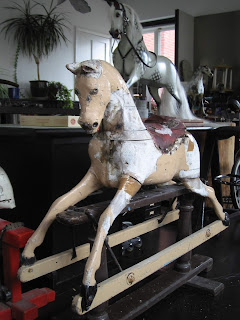I haven't detailed the stages of restoring Seraphine, as the process is the same as I used for Zaphod - even though every horse presents its own challenges. She is now finished and sold.
Here are her before and after photos:
Sunday, 25 November 2018
Saturday, 10 November 2018
Gesso
I used to be good at gesso - I've successfully gessoed two medium sized horses and a push horse, but found I'd forgotten the details of how to mix it. I knew from this blog that Anthony Dew's recipe is too watery, and needs lots more whiting than he says. The first coat I did was a bit too thick, and I had to do a lot of sanding - very dusty and I had to wear a mask.
Also, stains appeared, and on Seraphine's neck, this odd crack. I'd filled and sanded the wood carefully, and have no idea what caused this problem. I had nothing like this with Woot or Zaphod (but I guess many things can happen to a horse in more than a century). Gesso is supposed to be good at covering even rusty nails without the rust seeping through.
After some thought, I used a stain blocker on the patches, then gessoed over them. The gesso dried more slowly on the patches, and I used a hairdryer on cool setting to speed it up. By about the fourth coat of gesso, the patches were invisible.
This is the recipe I used:
500 milliliters water
45 grams granulated rabbit glue
550 grams whiting
I added the glue to the water and left to soak overnight. Then I heated it in a Pyrex mixing bowl over a pan of boiling water. Once the glue was dissolved, I added the whiting gradually, stirring to get rid of lumps and air bubbles. When the gesso was smooth like thin cream, I applied it to the horse with a flat brush.
You can take it off the heat to use, but stir from time to time and keep putting it back to heat up. It dries fast, and you can sand as necessary between coats, and if it goes well do the whole thing in a day. Six coats is about right, I think. It's a good idea to start with the horse on its side in order to gesso the belly and inside of the legs.
You can see Seraphine's extra carving on her neck and legs.
Also, stains appeared, and on Seraphine's neck, this odd crack. I'd filled and sanded the wood carefully, and have no idea what caused this problem. I had nothing like this with Woot or Zaphod (but I guess many things can happen to a horse in more than a century). Gesso is supposed to be good at covering even rusty nails without the rust seeping through.
After some thought, I used a stain blocker on the patches, then gessoed over them. The gesso dried more slowly on the patches, and I used a hairdryer on cool setting to speed it up. By about the fourth coat of gesso, the patches were invisible.
This is the recipe I used:
500 milliliters water
45 grams granulated rabbit glue
550 grams whiting
I added the glue to the water and left to soak overnight. Then I heated it in a Pyrex mixing bowl over a pan of boiling water. Once the glue was dissolved, I added the whiting gradually, stirring to get rid of lumps and air bubbles. When the gesso was smooth like thin cream, I applied it to the horse with a flat brush.
You can take it off the heat to use, but stir from time to time and keep putting it back to heat up. It dries fast, and you can sand as necessary between coats, and if it goes well do the whole thing in a day. Six coats is about right, I think. It's a good idea to start with the horse on its side in order to gesso the belly and inside of the legs.
You can see Seraphine's extra carving on her neck and legs.
Sunday, 4 November 2018
Seraphine
 Seraphine is a G & J Lines (Zaphod was a J & G Lines) dating from the late 19th century. She's named after the dragon in my novel, Trav Zander.
Seraphine is a G & J Lines (Zaphod was a J & G Lines) dating from the late 19th century. She's named after the dragon in my novel, Trav Zander.This is Seraphine as I bought her, with no lower jaw and truly depressing beige paint. I carved her a new jaw and ears, and replaced her missing eyes with new glass ones.

I've now cleaned up her brackets, swing irons and bowler hats with emery paper and painted them black, and started varnishing her stand. Since Zaphod's looked so good with four brushed on coats of Rustin's French Polish, I thought I'd do the same with Seraphine's stand. The turned posts were fine after three coats, but the rest of the stand for some reason is not; the finish is uneven, shiny in some places and matt in others after more than ten coats. I can only think it's the type of pine. The posts are a different wood, I'm guessing beech. Hmm.
Saturday, 3 November 2018
Subscribe to:
Posts (Atom)










